 Embarking on a decluttering journey is akin to opening a door to a lighter, more organized life. The mere thought of sifting through the drawers, closets, and cupboards may evoke mixed emotions, but it’s time. We accumulate possessions, assign meaning to them, and find reasons to hold on – perhaps we’ll need it someday, or it’s good to have a spare, just in case.
Embarking on a decluttering journey is akin to opening a door to a lighter, more organized life. The mere thought of sifting through the drawers, closets, and cupboards may evoke mixed emotions, but it’s time. We accumulate possessions, assign meaning to them, and find reasons to hold on – perhaps we’ll need it someday, or it’s good to have a spare, just in case.
As our spaces fill up, so do our minds, making it challenging to locate what we truly need. But fear not, for we’ve compiled a thoughtful list to guide you on your path to simplifying life and embracing sustainability. This isn’t an exhaustive inventory; rather, it serves as a starting point for reflection. We all need essentials for living, working, and playing, yet when possessions become burdens, it’s time to reassess.
Consider parting ways with the unnecessary, broken, unused, and out-of-style items. Decluttering not only frees up physical space but also brings peace of mind. Our list is a gentle nudge to help you identify items that can find a new home or purpose. Should you need to replace something, decluttering unveils those gaps, allowing you to make mindful choices aligned with your current lifestyle.
Feel free to explore the list and embark on a daily decluttering journey. Letting go, one item at a time, for a year may seem like a challenge, but the satisfaction it brings is unparalleled. Best of luck with your decluttering adventure! Share your progress with us and contribute to our evolving list of considerations. Happy decluttering!
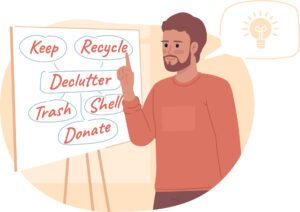 Getting Started
Getting Started
For a more organized and effective decluttering process, start by implementing a simple 5-bin system. This doesn’t have to be intricate; just gather five bags, boxes, or bins for categorizing your items. They don’t necessarily have to be in the same location, label or designate each container accordingly:
 Bin #1 – Trash:
Bin #1 – Trash:
Use your regular trash bin for items that are no longer usable or needed.
 Bin #2 – Treasures:
Bin #2 – Treasures:
Deciding to part with items of sentimental value is a personal choice that should bring joy, not regret. Strive for a balance that suits you. Remember, not all sentimental items need decluttering; if an item brings joy or has practical use, it’s not clutter. Here are some tips to help in this area:
- Gift Guilt: Release the guilt associated with unused gifts. Regift or donate them to someone who will appreciate them.
- Display and Share Memories
- Prominent Display: Showcase sentimental items – frame children’s artwork, hang heirloom plates, etc.
- Share with Family: Offer sentimental items to family members who can enjoy and display them.
- Keep One; Lose the Rest: Displaying one meaningful item can be more impactful than storing a full set.
- Cherish Memories, Lose Clutter: Acknowledge and cherish memories, photographing items before parting with them.
- Functional Transformation: Turn valuable items into something functional, like creating a pillow from a loved one’s shirt.
- Donate Profits: If selling online, consider donating the proceeds to a cause you believe in to add purpose to your choice.
- Digital Memories: Scan letters, journals, or special toys; take photos to preserve memories without physical clutter.
- Passing Heirlooms: Pass on heirlooms to family, friends, or community museums, preserving their significance.
- Remake or Repurpose: Get creative with sentimental items – create quilts or remake jewelry to give them new life.
- Selective Keeping: Keep one or a few items from a collection or group, sharing the joy with family and friends.
- Memory Scrapbook: Create a scrapbook consolidating photos and notes about the significance of sentimental items.
- Donate: Opt for bags here, making it convenient for drop-offs. Once filled I put these in the trunk of my car so I don’t forget to take them to the donation donation destination. This saves trips and gas as well.
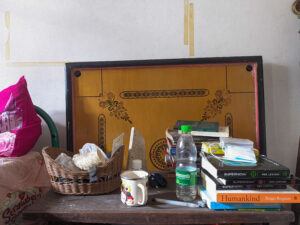 Bin #3 – Put Away:
Bin #3 – Put Away:
Allocate a designated box or container for items that need to be returned to their proper places within your home, such as misplaced items, kids’ toys, or stray socks. Place it strategically, at the bottom of your stairs, in a hallway, or in another convenient location, as long as it’s easily noticeable. This simplifies the process of identifying items that should be returned to their respective spaces as you move around your home. This can be an enjoyable and engaging activity for children. It is a truly useful activity that helps them see the value of things.
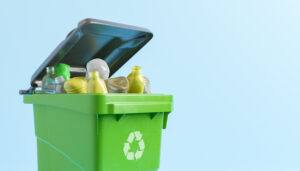 Bin #4 – Recycle
Bin #4 – Recycle
This container is designated for items meant for consignment, regifting, selling, or sharing with someone who would appreciate them. What one person discards can often become another person’s treasure.

Bin #5 – Maybe:
Exercise caution with this container. It’s a temporary holding space for items you’re struggling to let go of. Let items be there for up to six months, and mark each item with its placement date. Periodically reevaluate your attachments. Some items may still have value, while others might be ready for release.
As you make decluttering a regular habit, you’ll likely find it easier to part with items, reducing the contents of the “Maybe” container over time. This systematic approach helps streamline decision-making and ensures a smoother decluttering experience.
Scan through this list to identify items for easy decluttering. Start with the straightforward ones and, as you gain confidence and allocate more time, tackle larger decluttering tasks.
Clothes and Accessories
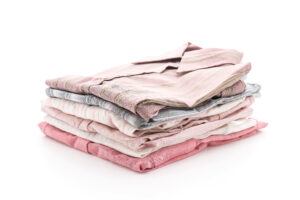 When sorting through this category, think about the last time each item was used. If it has been more than a year, it might be a release candidate. During decluttering, it is common to say “what if”. If you find it challenging to part with an item, place it in your maybe bin. You’ll be surprised at how effortless it becomes to release items after the waiting period. That shirt you purchased for its color one event or clothing that no longer fits due to weight changes. After six months, perspectives often shift, and the initial “what if” concerns tend to diminish.
When sorting through this category, think about the last time each item was used. If it has been more than a year, it might be a release candidate. During decluttering, it is common to say “what if”. If you find it challenging to part with an item, place it in your maybe bin. You’ll be surprised at how effortless it becomes to release items after the waiting period. That shirt you purchased for its color one event or clothing that no longer fits due to weight changes. After six months, perspectives often shift, and the initial “what if” concerns tend to diminish.
While reviewing this list, consider the following questions: How many of these do I actually need? When was the last time I used this item? Do I still like it? Does it fit? Does it work? Is it broken?
See if you can pick one item from the list and declutter it today.
- Accessories
-
- Belts
- Hair clips
- Hair ties and headbands
- Men’s ties
- Backpacks
-
- If you have more than one, how will you use them?
- Button-up shirts
- Clothes that no longer fit you or your life
- Costume Jewelry (A few special pieces will be due for all occasions)
- Formal attire (you’ve worn them to the same yearly event several times)
- Gloves (multiple styles and warmth are appropriate, but one of each is enough)
- Hats (one for each season and or type, garden, walking, sports, etc.)
- Makeup bags (one for travel, one for the car or purse)
- Nail polish
- Old unused makeup
- Phone cases (that aren’t in use)
- Phones (that aren’t in use)
- Purses (too big, too little, not in style)
- Reading glasses
- Scarves (sort by color keep one of each and let go of the rest)
- Socks with holes
- Socks with no mates
- Sunglasses (one for home, one for the car, 2 spares)
- T-Shirts/Underwear (with holes)
- Unopened makeup
- Wallets (that lay empty and never used)
- Worn out shoes
Home and Kitchen
- Cracked coffee mugs and dishes
- Dead or neglected plants
- DVDs that won’t be watched again
- Excessive towels and linens
- Food storage containers lacking lids
- Forgotten and unused utensils
- Games no longer played
- Kitchen appliances gathering dust
- Last year’s calendar or planner
- Mixing bowls
- Out-of-style house decor
- Piles of unnecessary paper clutter
- Picture frames you’re not going to use
- Puzzle books you’ve completed
- Serving trays never used
- Small appliances
- Storage bins devoid of stored items
- Supplies for hobbies you won’t pursue
- Things you have duplicates of
- Towels you don’t like
- Tupperware/plastic containers
- Unnecessary cleaning tools
- Unneeded buckets
- Unused and unnecessary cords and remotes
- Unused cookbooks (considering the digital alternatives)
- Unused cooking utensils
- Unused sweaters (from deep in your dresser)
 Electronics and Media
Electronics and Media
- Cameras you don’t use (it’s all digital now)
- Computer games
- Digital clutter (this is a pretty large project one for when you have the time)
- Old replaced phones
- Small electronics (no longer in use)
- Televisions (you don’t use)
- Unused boombox or stereo
- Unused cords and remotes
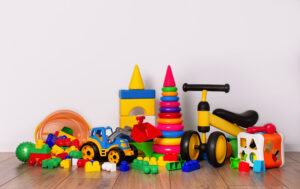 Kids’ Items
Kids’ Items
- Toys (your children have outgrown)
- Baby clothes
- Outgrown kid’s clothes
- Kid’s step-stools (that are not being stepped on)
- Kid’s toys (that are unplayed with)
- Stuffed toys
- Tiny things (that aren’t played with)
- Books (the kids have outgrown)
Hobby and Sports Equipment
- Exercise equipment (you don’t and won’t use)
- Supplies for hobbies (you won’t do)
- Sports equipment (from your old hobby)
- Outdoor play equipment (that isn’t serving a purpose for you)
Miscellaneous
- Books (you won’t read again and never did)
- Jars (you only like to look at)
- Magazines or newspapers (you’ve already read)
- Old receipts
- Unworn sweaters (from deep in your dresser)
Where to recycle the stuff you declutter
- Friends and family (regift, repurpose)
- Libraries (library foundations that have book sales)
- Electronic recycling resource
- Thrift stores (Be sure to check what they take and don’t so the item doesn’t wind up in the trash)
- Curbside recycling (Check the rules on what is allowed)
- Freecycle (link)
- Consignment (Check online for local consignment for gently used clothing)
- Store these things
- Seasonal items
- Specialty Cookware
When it comes to replacing broken, cracked, or unused items with more suitable alternatives, there are sustainable options that offer long-lasting, eco-friendly choices. Shifting towards fewer, eco-friendly products can impart a simple, clean feel to your home, creating a decluttered, natural environment that feels healthy and brings a smile to your face. We reccomend Eco Roots as a source for sustainable eco friendly products that will last and be good for the environment.
Remember, the decisions of what to keep or let go are personal. Scientific studies show that reducing excess belongings and embracing simplicity can heighten joy in your home and life. Clearing space in your living environment cultivates gratitude for your possessions, contributing to a sustainable life with fewer items.
We use Affiliate Links to sustain Simply Sustainable Lifestyle’s writing and research. We curate goods and services that enrich the simple and sustainable lifestyle experience. As an Amazon Associate I may earn from qualified purchases
Your feedback on products and services, whether great or falling short, is invaluable in aligning recommendations with the blog’s focus.
We’d love to hear from you about this article or our website. Please make comments below and take a minute to sign up to be on our email list. We will periodically send you notifications of new blogs you won’t want to miss.

Here at EcoRoots, is on an endless mission to provide you with the best eco-friendly and low-waste products out there. The products are kindly made for every person, every body, every identity. From beauty and health to household products, our eco-friendly lineup is here to help you find sustainable alternatives to everyday essentials!

Earth Breeze is on a mission to make high quality, low-waste products that deliver meaningful environmental and social impact for a more sustainable future, because small acts now make a huge impact tomorrow.
Every time you use an Earth Breeze product you are reducing single-use plastic waste and helping someone in need.




This article is amazing! I am instinctually reducing the amount of clutter in my home constantly. I find it is easier to have less than take care of too many items in my life. But, I struggle with sometimes getting rid of too much that I might need or that my children will someday want to revisit. I really appreciated the breakdown of your treasures section that helped decide what items might serve further purposes. This entire article is organized so clearly and easy to follow that I will definitely be revisiting.